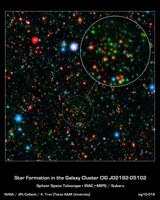
Figure 1
Click on the image for the larger versionAstronomers have found that stars are forming more rapidly in the center of a distant galaxy cluster than at its edges, which is completely reversed from galaxy clusters seen in the local universe. This cluster, designated CLG J02182-05102, is shown in Figure 1.
The image combines infrared light from NASA's Spitzer Space Telescope with visible light from Japan's Subaru telescope atop Mauna Kea, Hawaii. This sensitive exposure captures galaxies that are relatively local along side some that date back almost 10 billion years, soon after the Big Bang. The most distant galaxies stand out clearly in the infrared, rendered here in green and red.
What is noteworthy is how many of these galaxies are particularly bright at the longest infrared wavelengths, appearing red in this image. This glow indicates these ancient galaxies are still actively forming stars, even near the core of the cluster. In our local portion of the universe, the cores of galaxy clusters are known to be galactic graveyards full of massive elliptical galaxies composed of old stars.
The group's discovery holds potentially compelling implications that could ultimately reveal more about how such massive galaxies form. Now that they have pinpointed the epoch when galaxy clusters are making the last of their stars, astronomers can focus on understanding why massive assemblies of galaxies transition from very active to passive. The galaxies here may represent a missing link between the active galaxies and the quiescent behemoths that live in the local universe.
Infrared light from Spitzer at wavelengths of 4.5 and 24 microns is rendered in green and red, respectively. Subaru observations of visible light at a wavelength of 0.7 microns are rendered in blue. These data are part of the Spitzer Wide-area InfraRed Extragalactic (SWIRE) survey.

